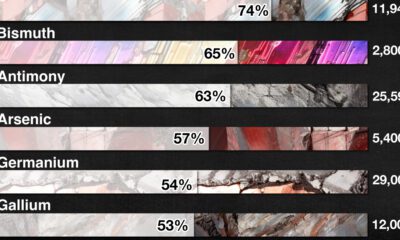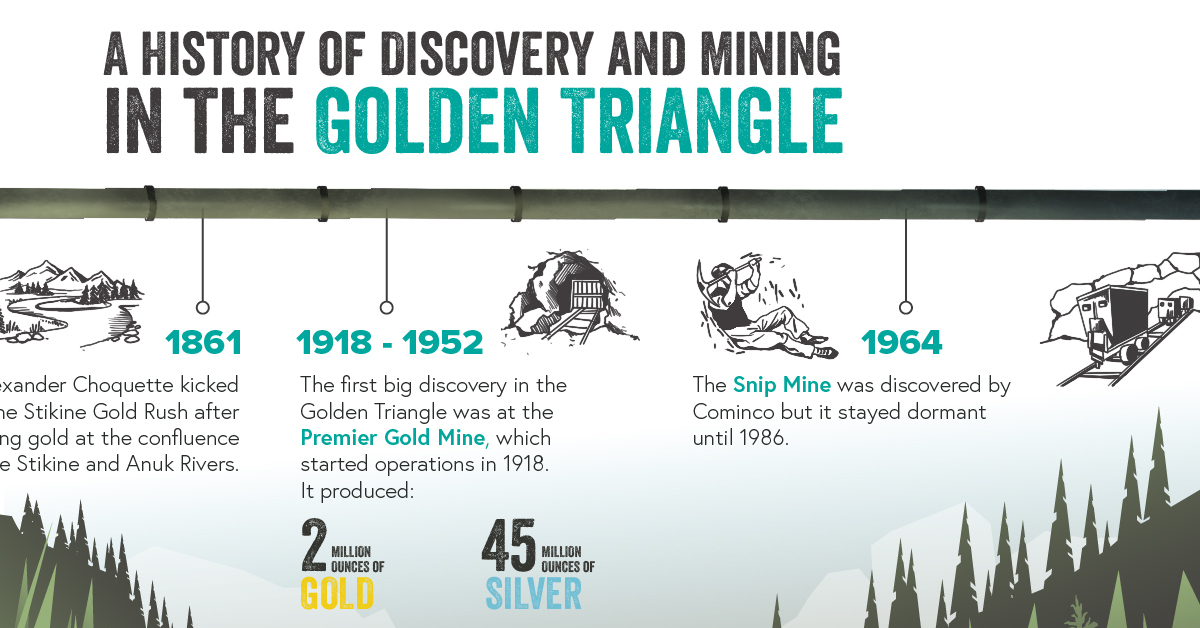Visualizing the Economic Impact of British Columbia’s Golden Triangle
The following content is sponsored by British Columbia Regional Mining Alliance (BCRMA).

The Economic Impact of British Columbia’s Golden Triangle
At the heart of British Columbia’s mining industry lies the Golden Triangle. This region has helped transform the province’s mining industry into a significant source of revenue and investment.
In 2020, the Golden Triangle accounted for roughly 44% of the $422 million in mineral exploration expenditures in British Columbia. In 2019, the Red Chris and Brucejack mines contributed around $1 billion to the province’s estimated annual gross mining revenues.
This infographic is sponsored by the B.C. Regional Mining Alliance (BCRMA) which brings the best of this region to the world through a partnership between indigenous groups, industry, and provincial government representatives.
Here is how the Golden Triangle began.
The Golden Triangle’s Unique Geology
Between 220 and 175 million years ago, the Golden Triangle’s wealth was forming deep in the Earth for the world to discover. Most metal deposits form from superheated water that cycle over many kilometers, collecting metal atoms as they rise to the surface of the Earth’s crust and settle into deposits.
Industry, government, and university geologists have worked for over a century to understand the Golden Triangle’s unique geology to uncover its mineral wealth. This unique geology cradles the world-class deposits that define the legendary “Golden Triangle” of British Columbia.
A History of Discovery and Mining in the Golden Triangle
Historical gold rushes brought mining to the area, but the region’s vast copper deposits will deliver the key mineral for B.C.’s green future. More than 150 mines have operated in the area since prospectors first arrived at the end of the 19th century.
- 1861: Alexander Choquette kicked off the Stikine Gold Rush after finding gold at the confluence of the Stikine and Anuk Rivers.
- 1918 – 1952: The first big discovery in the Golden Triangle was at the Premier Gold Mine, which started operations in 1918. It produced 2 million ounces of gold and 45 million ounces of silver. Today, Ascot Resources is re-starting processing from this gold mine.
- 1964: The Snip Mine was discovered by Cominco but the deposit stayed dormant until 1986. The mine produced approximately 1 million ounces of gold from 1991 until 1999. Today, Skeena Resources is advancing the Snip Project.
- 1994: Eskay became Canada’s highest-grade gold mine and the world’s fifth largest silver producer, with production above 3 million ounces of gold and 160 million ounces of silver. Skeena Resources is also bringing the Eskay mining back into production.
- 2009: The discovery of the Brucejack gold and silver deposit led to the development of an underground mine. The mine has produced 1,230,644 ounces of gold since it began operations in 2017.
- 2013: The KSM Project is one of the largest undeveloped gold projects in the world. A Preliminary Feasibility Study estimates proven and probable reserves total 38.8 million ounces of gold and 10.2 billion pounds of copper.
- 2015: The Red Chris shipped its first load of copper concentrate. In 2020 metals production was 88.3 million pounds copper and 73,787 ounces gold. Imperial Metals and Newcrest jointly operate the mine.
This long tradition of discovery and mining is laying the foundations for the next generation of investment.
Today’s Golden Age for Exploration and Development
Continued exploration is necessary for new discoveries and advancing projects to new mines. More importantly, the minerals discovered today will be needed in the low carbon economy and British Columbia—in particular, the Golden Triangle will play its part in delivering metals for renewable technology.
| British Columbia | Northwest Mining Region | The Golden Triangle | |
|---|---|---|---|
| 2020 Projects | 259 | 67 | 26 |
| Total Expenditures | $422M | $255M | $184M |
| Drilling (meters) | 991,319 | 470,058 | 352,247 |
| Average Expenditure Per Project | $1.6M | $3.4M | $7.09M |
Source: Based on data collected for the EY LLP, 2020 British Columbia Mineral and Coal Exploration Survey
Gold and copper account for most of the exploration in the Golden Triangle, but other commodities for the low-carbon economy such as silver, nickel, and zinc also attract interest. A strong exploration industry is the beginning for future investment, new jobs, and community development.
A Bright Future: Investing in Community
The Golden Triangle continues to attract exploration activity as infrastructure and community development lays the success for future generations and industries.
Community:
- Agreements with First Nations (Tahltan and Nisga’a Nations)
- 38% of expenditures stays in the region
- 97% stays in British Columbia
- 150+ communities benefit
Infrastructure:
- The paving of the Stewart-Cassiar highway
- The opening of ocean port facilities for concentrate export at Stewart
- The completion of a $700-million high-voltage transmission line bringing power into the region
This is a new beginning for the continued economic impact of British Columbia’s Golden Triangle.
-

 Mining2 days ago
Mining2 days agoGold vs. S&P 500: Which Has Grown More Over Five Years?
The price of gold has set record highs in 2024, but how has this precious metal performed relative to the S&P 500?
-

 Mining2 weeks ago
Mining2 weeks agoCharted: The Value Gap Between the Gold Price and Gold Miners
While the price of gold has reached new record highs in 2024, gold mining stocks are still far from their 2011 peaks.
-

 Uranium2 months ago
Uranium2 months agoCharted: Global Uranium Reserves, by Country
We visualize the distribution of the world's uranium reserves by country, with 3 countries accounting for more than half of total reserves.
-

 Markets3 months ago
Markets3 months agoThe Periodic Table of Commodity Returns (2014-2023)
Commodity returns in 2023 took a hit. This graphic shows the performance of commodities like gold, oil, nickel, and corn over the last decade.
-

 Strategic Metals3 months ago
Strategic Metals3 months agoChina Dominates the Supply of U.S. Critical Minerals List
The U.S. Geological Survey estimates that in 2022, China was the world’s leading producer of 30 out of 50 entries on the U.S. critical minerals list.
-

 Mining5 months ago
Mining5 months agoThe Critical Minerals to China, EU, and U.S. National Security
Ten materials, including cobalt, lithium, graphite, and rare earths, are deemed critical by all three.


